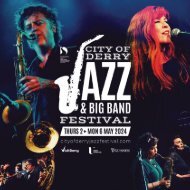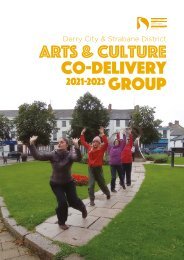Derry & Strabane: Natural Capital Report of Outdoor Recreation Spaces 2021
An analysis of the true social, health, economic and environmental value of green and blue spaces in our District using Natural Capital Accounting.
An analysis of the true social, health, economic and environmental value of green and blue spaces in our District using Natural Capital Accounting.
Create successful ePaper yourself
Turn your PDF publications into a flip-book with our unique Google optimized e-Paper software.
The benefits <strong>of</strong> public greenspaces to Northern Ireland<br />
1<br />
Environmental benefits<br />
Greenspaces incorporate natural drainage, protecting physical infrastructure. Cities can be more prone to<br />
surface water flooding without vegetation and soils that can absorb and store water. Green infrastructure<br />
facilitates flood management through soil infiltration, by intercepting rainfall and by reducing peak flows<br />
(Chin, 2009). As climate change is likely to result in increased rainfall, storms and rising sea levels, urban<br />
floods are expected to intensify. Approximately 45,000 or 5% <strong>of</strong> properties in NI are located in the areas<br />
at higher risk <strong>of</strong> fluvial or coastal flooding (Department for Infrastructure, 2019). Some cities in the region<br />
have already recognised the importance <strong>of</strong> addressing these risks, and the potential benefits <strong>of</strong> green<br />
infrastructure. For example, Belfast has invested in creating green continuous networks and corridors for<br />
flood management (Belfast City Council, 2017).<br />
Greenspaces help manage greenhouse gas (GHG) emissions and pollution in cities. Trees and vegetation<br />
in greenspaces sequester GHGs and trap air pollutants that are harmful to human health. In addition,<br />
greenspaces can support reduced GHG emissions by facilitating increased pedestrianisation and<br />
reductions in vehicle use. In NI, the highest emitting industries are agriculture, transport and energy supply<br />
(Northern Ireland Statistics and Research Agency, 2020). Targeting these challenges in parallel to creating<br />
more pedestrian-friendly and vegetated cities can help manage air pollution levels and improve health<br />
outcomes.<br />
Greenspaces can reduce the urban heat island effect and climate risks. Cities tend to have warmer<br />
temperatures compared to rural areas due to the concentration <strong>of</strong> infrastructure. This phenomenon is<br />
referred to as the ‘urban heat island effect’ (UHI). Increased temperatures resulting from UHI can lead to<br />
increased stress, reduced productivity and mortality. These negative effects can be reduced by cooling<br />
effects <strong>of</strong> water bodies through evapotranspiration, and through vegetation. These benefits are likely to be<br />
more limited in NI communities where cities are relatively small and the climate is temperate.<br />
10

















